The Ultimate Guide to Warmest Wetsuits for Kiteboarders
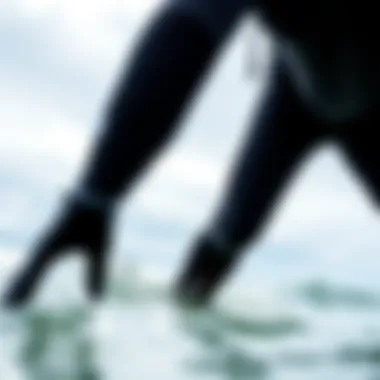
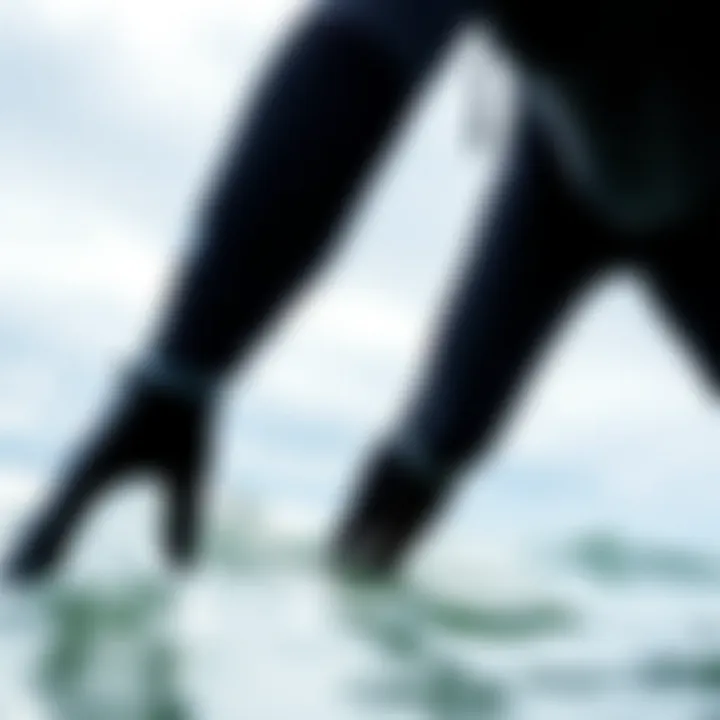
Intro
For those who dare to conquer the windy waves, kiteboarding offers an unmatched thrill. However, where there’s wind, there’s often cold water. Kiteboarders know all too well the importance of staying warm while riding the swells. Thus, the choice of wetsuit isn't just a matter of preference; it’s a critical element for comfort, safety, and performance. When you're slicing through chilly waters, the right wetsuit can be the difference between a day of exhilarating rides or a cold, miserable outing.
This guide aims to go beyond the surface, diving deep into the nitty-gritty of wetsuits designed specifically for kiteboarding enthusiasts. We’ll explore materials, fit, insulation, and design elements tailored to the rigors of the sport. Whether you’re a newbie still figuring out the ropes or a seasoned kiteboarder, the insights shared here will help you make informed choices. So, let’s hit the waves with knowledge as our ally!
Equipment Insights
Latest Gear Reviews
When it comes to the warmest wetsuits on the market, several brands stand out, each offering unique benefits tailored for kiteboarders.
- O'Neill Psycho Tech: This wetsuit is celebrated for its exceptional thermal properties. The TechnoButter neoprene provides both warmth and flexibility, making it a go-to for cold water conditions. Users have noted that its seamless design reduces water ingress, keeping you cozy, even in biting temps.
- Rip Curl Flashbomb: Another contender, the Flashbomb uses a unique combination of insulation layers that trap warmth without adding bulk. This suit is equipped with a quick-drying interior, making it ideal for those who want to hit the water soon after a short rain delay.
- Billabong Furnace: Not to be overlooked, the Furnace offers excellent insulation with minimal weight. It boasts eco-friendly materials that deliver on performance, pairing warmth with sustainability – a very appealing duality for the conscientious kiteboarder.
Selecting the right wetsuit largely depends on fit, thickness, and personal preference regarding mobility. Kiteboarding demands significant movement, and therefore, you'll want a wetsuit that doesn’t constrict you like a vice. Look for suits that carry ergonomic designs aligning with the physical dynamics of kiteboarding.
Essential Gear Maintenance
A wetsuit is an investment, so proper care is crucial for longevity and performance. Here are some handy maintenance tips to keep your wetsuit in top shape:
- Rinse It: After a day on the water, rinse your wetsuit thoroughly with fresh water. Salt and sand can degrade the material over time.
- Hang Dry: Always hang your suit upside down (legs up) in a cool, shaded spot. Avoid direct sunlight, as UV rays can break down the neoprene.
- Avoid Washing Machines: Resist the temptation to toss your wetsuit in the wash. Chemical detergents and tumbling dry can damage the suit’s integrity.
- Store Properly: When the season ends, store your wetsuit flat or rolled up loosely. This way, it won’t retain creases that can stress the fabric.
By following these simple guidelines, you can prolong the life of your wetsuit, ensuring that it continues to provide warmth and protection when you need it most.
Ending
In summary, a solid wetsuit can transform your kiteboarding experience in cold waters, ensuring you remain warm and agile. With a plethora of options available on the market, selecting the right one involves considering aspects like material, fit, and functionality. With maintenance practices in place, your wetsuit can remain a reliable companion for seasons to come.
Understanding Wetsuits
Wetsuits are not just casual gear for any water sport; they play a crucial role in kiteboarding, especially in colder conditions. Kiteboarders often face the challenge of chilly winds and cold waters that can sap the warmth away quickly. Understanding wetsuits enables enthusiasts to navigate these waters while maintaining comfort. This section focuses on the essential aspects that define a suitable wetsuit for kiteboarding, inclduing its composition, design, and functionality.
Definition and Purpose
A wetsuit is essentially a tight-fitting garment made from neoprene, designed to keep the body warm in cold water. It serves more than just a protective purpose; it also offers buoyancy and minimizes wind chill. Kiteboarders, by the nature of the sport, need to be particularly aware of thermal regulation when in and out of the water. Choosing the right wetsuit can mean the difference between enjoying a day on the water and being forced to call it quits due to discomfort.
How Wetsuits Function
Understanding how wetsuits work is vital for kiteboarders looking to make an informed choice when purchasing their gear. The effectiveness of a wetsuit lies in its design and materials, which come together to create a barrier against the elements.
Thermal Insulation Mechanism
The thermal insulation mechanism of a wetsuit is primarily what allows it to keep your body at a comfortable temperature in cold waters. The key characteristic here is that during wear, a wetsuit traps a thin layer of water between the fabric and the skin. Body heat warms this water, providing insulation. This creates a shield of warmth while the wetsuit itself is made of neoprene, a fantastic insulator. This is why it’s the go-to choice for water sports enthusiasts.
However, it's worth noting that not all neoprene is created equal. Some types have better insulating properties than others. A thicker neoprene can provide better warmth but may sacrifice flexibility, an important factor for kiteboarding maneuvers. Ultimately, the balance between thickness and flexibility might dictate the user experience, thus making it a vital consideration while choosing.
Water Resistance Features
Water resistance features are another critical element of wetsuits. Water resistance is mainly achieved by the materials used and the construction quality of the wetsuit. A well-constructed wetsuit with clever sealing technology can mean that less water seeps in. This is particularly beneficial in kiteboarding, as water entry can lead to rapid cooling.
Wetsuits usually come with various seam techniques such as flatlock seams, which are great for breathability but may not be ideal for water resistance. Sealed or glued seams can provide considerable advantages in preventing water entry. Choosing a wetsuit with superior water resistance features can keep kiteboarders warm for longer durations on the water without the chilling effects of cold water seepage.
Factors Affecting Warmth
Choosing the right wetsuit for kiteboarding is not just about picking a popular brand or a flashy design. It hinges significantly on understanding the factors that contribute to the warmth and overall performance of the wetsuit. Kiteboarding often takes place in chilly waters, and without the right gear, one can feel as cold as ice, resulting in discomfort and reduced enjoyment during this thrilling sport. This section dives deep into the elements that can influence warmth, ensuring you make an informed decision that enhances your time on the water.
Material Composition
Material plays a pivotal role in a wetsuit's ability to provide warmth. Most wetsuits are crafted from neoprene, which is a synthetic rubber known for its insulating properties. This section turns a spotlight on two key aspects: neoprene varieties and thickness considerations.
Neoprene Varieties
Neoprene comes in several varieties, each having distinct properties that can affect warmth retention. Standard neoprene is often used in wetsuits, but there are higher-end types like limestone neoprene which offer better flexibility and warmth.Given that kiteboarders often need to perform dynamic movements, the flexibility from high-quality neoprene becomes a major factor.
Most modern wetsuits also use super stretch neoprene which enhances the comfort level. The key characteristic of these materials is their ability to trap a thin layer of water between the suit and the skin, which is then warmed by body heat. It’s a clever balance of design and functionality, making heavier wetsuits with denser neoprene less favorable for kiteboarding due to buoyancy issues.
However, keep in mind that while higher-end neoprene can be more effective, it usually comes with a higher price tag which might not fit all budgets. The choice boils down to the balance one wants to find between warmth and cost.


Thickness Considerations
Thickness is another important element when it comes to maintaining warmth in a wetsuit. Wetsuits typically range from 2mm to 7mm in thickness. The thicker the wetsuit, the more thermal insulation it generally offers, which is crucial in colder waters.
For kiteboarding, many enthusiasts prefer a 4/3mm wetsuit for its warmth without being overly restrictive. The unique feature of varying thickness also allows water sports enthusiasts to choose suits that adapt to the specific water temperatures they expect to face.
A thicker wetsuit can limit mobility and increase drag, making it harder to maneuver on the water. Hence, while thicker suits are warmer, they also can impact performance, leading many to favor thinner options in milder conditions.
Wetsuit Design
The design of a wetsuit can greatly influence its insulation efficiency. This isn't just about aesthetics; features such as seams and stitching techniques, as well as internal linings and coatings, can make a significant difference in warmth retention and comfort.
Seams and Stitching Techniques
Seam construction is crucial for warmth. There are a few types of seams used in wetsuit manufacturing, including flatlock seams which are durable but can allow some water entry. On the other hand, sealed seams are specifically designed to prevent water entry.
The key characteristic of high-end models is often found in their use of blind stitched seams that offer both strength and added insulation by preventing water leakage. Choosing a wetsuit with carefully constructed seams can ultimately make a difference between a pleasant session and a chilly experience.
Internal Linings and Coatings
Internal linings, such as thermal fleece or titanium-coated materials, can significantly enhance the warmth of a wetsuit. These linings trap body heat and provide an extra layer of insulation. The key characteristic here is their ability to wick moisture away, keeping the wearer dry and warm.
Some wetsuits feature internal insulation layers designed not just to keep heat in but to facilitate quick drying times. While these linings can increase the overall cost, their benefits often outweigh the investment for serious kiteboarders who prioritize comfort in colder conditions.
Fit and Sizing
Ultimately, the fit of a wetsuit is among the most crucial aspects of both warmth and performance. A well-fitted wetsuit minimizes water entry and optimizes insulation. This section will address the importance of proper fit and how adjustments can enhance comfort without compromising performance.
Importance of Proper Fit
A wetsuit should fit like a second skin. The key characteristic of a properly fitted wetsuit is that it should feel snug yet not restrictive. Loose areas can allow cold water to seep in which defeats the purpose of keeping warm. Missing out on the right fit can leave the kiteboarder at the mercy of the cold, damp conditions.
Many high-quality wetsuits come in a variety of shapes and sizes, accommodating different body types. It’s advisable to try on several makes and models, since brands often vary in their sizing standards.
Adjustments for Comfort
Once an appropriate wetsuit size is determined, minor adjustments may be necessary to maximize comfort. Many wetsuits are designed with adjustable collars and cuffs to prevent unwanted water ingress, keeping wearers warm.
The key aspect of these adjustments lies in their ability to provide a custom fit to an individual's body shape. Adjusting straps or using entry methods like chest zippers can make a difference in warmth and comfort. However, it's essential to ensure adjustments enhance your experience rather than impair mobility, so consider practicing removal and re-entry with your adjustments in mind.
In this complex world of wetsuits, understanding the factors affecting warmth is not just about staving off cold; it's about enhancing your entire kiteboarding experience. So, as you gear up to hit the waters, consider each of these specifications to find the perfect wetsuit, one that aligns with both your performance needs and comfort.
Types of Wetsuits
When discussing the right gear for kiteboarding, the types of wetsuits available play a significant role. Each type serves a unique function and comes with its own set of advantages and drawbacks. Understanding these differences helps kiteboarders tailor their choice based on personal needs and the conditions they’ll face. This section examines various wetsuit types, including full wetsuits, shorties and springsuits, as well as hybrid suits, ensuring that every kiteboarder can find something suited for their adventures in the water.
Full Wetsuits
Best Use Cases
Full wetsuits are often seen as the go-to option for kiteboarders who navigate colder waters, providing complete coverage from neck to ankle. This makes them ideal for regions with frigid temperatures or those who plan to spend extended periods in the water. Their snug fit creates a barrier that traps a thin layer of water, warming it with body heat.
What makes full wetsuits such a popular choice is their ability to combat the chill effectively. A full suit reduces the risk of hypothermia, enabling riders to focus on their performance rather than shivering through sessions. Yet, while beneficial, their weight and coverage can sometimes restrict mobility.
Temperature Ranges
Recognizing the temperature ranges is vital when selecting a full wetsuit. They are generally categorized based on the thickness of the neoprene used, which can vary from 3mm to 5mm or more, depending on the suit design. In general, a 3mm wetsuit could be suitable for water temperatures upwards of 65°F, while a 5mm might be needed for temperatures dipping lower than 50°F. This distinction allows kiteboarders to select a full wetsuit that matches their specific environment.
It's worth noting that thicker suits can increase warmth but may lead to less flexibility. Therefore, striking a balance between thickness and the desired mobility is essential for performance and comfort in icy waters.
Shorties and Springsuits
Features and Limitations
Shorties and springsuits are shorter in design, typically covering the torso and either the arms or legs, making them ideal for warmer water conditions. The primary advantage of these suits is their lightness, which allows for greater freedom of movement. They are often made with lighter materials and are easier to put on and take off compared to full wetsuits.
However, while they excel in warm weather, they do come with their limitations. The coverage provided is less than a full wetsuit, meaning they may not retain warmth effectively in cooler temperatures. This can become a drawback during spring or fall sessions when the water temperature can be deceivingly cold beneath a sunny sky.
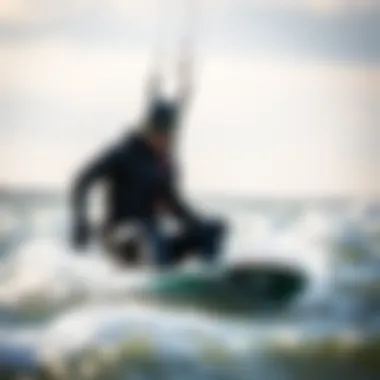
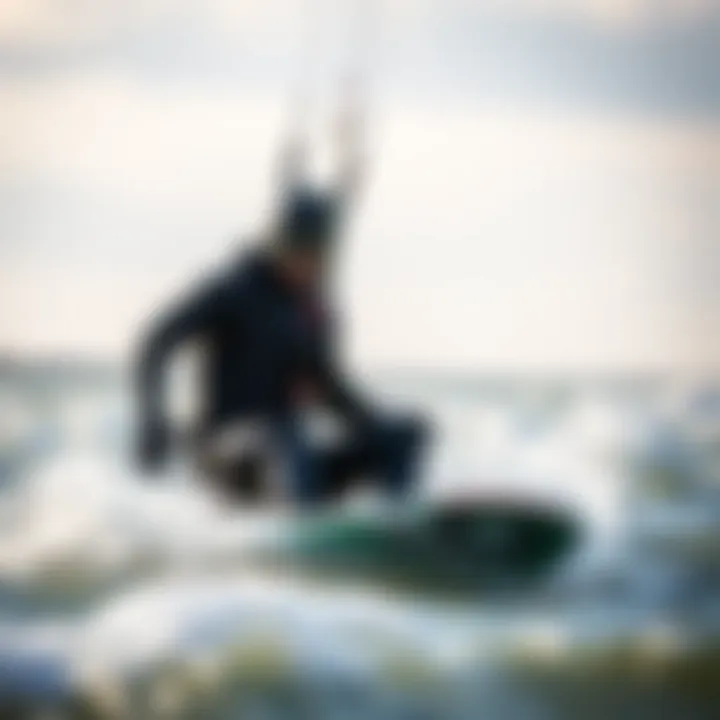
Suitability for Warmer Waters
As the name suggests, shorties and springsuits shine when the temperatures rise. They are ideal for kiteboarders wanting to stay cool yet somewhat protected from UV rays and minor scrapes. For warmer climates where kiteboarding is popular year-round, these suits allow for good ventilation and comfort. This lightweight design allows body heat to escape, keeping the rider from overheating.
However, boarders must be cautious; these suits can leave one vulnerable as the day progresses and temperatures drop. Being aware of the environment one is heading into can help decide whether a shorty or springsuit meets the needs of the session.
Hybrid Wetsuits
Combining Thickness and Flexibility
Hybrid wetsuits are an innovative option that many kiteboarders are gravitating towards. They bring together the thicker neoprene of full wetsuits with the flexibility found in lighter suits. A hybrid wetsuit can provide the best of both worlds by using different thicknesses in various areas. For example, extra warmth around the torso while keeping arms and legs more flexible, which is a game changer for those who value maneuverability in their sport.
This versatility allows for enhanced performance when kiteboarding in variable conditions. However, some may find that the cost is slightly higher than traditional options—a trade-off for more specialized features.
Performance in Variable Conditions
For kiteboarders, performance in unpredictable conditions is a must. Hybrid wetsuits can handle a range of temperatures and weather fluctuations due to their unique design. Whether it’s a sudden wind chill or a splash of refreshing water, these suits adapt, offering both warmth and the necessary stretch to keep an athlete agile.
Nevertheless, hybrid suits may not be as efficient as full wetsuits in extreme cold. It's essential to weigh personal preference against the seasonal temperature when making a selection. The advantage of hybrids is clear: a kiteboarder could use the same suit in varying situations, making it a cost-effective choice for many.
Brand Comparisons
Brand comparisons are a crucial aspect when choosing the ideal wetsuit for kiteboarding. Given the variety of brands, each with its unique features and benefits, this section will help you navigate through some of the top players in the market. Understanding the strengths and weaknesses of different manufacturers aids enthusiasts in making informed decisions. After all, a well-made wetsuit can enhance performance, boost comfort, and even extend the time you can spend on the water.
Top Wetsuit Manufacturers
Industry Leaders
Industry leaders in wetsuit manufacturing have set the benchmark for quality and performance. For kiteboarders, brands like O'Neill, Rip Curl, and Quiksilver consistently top the charts in terms of innovation and reliability. These companies are known for using advanced materials and technologies that provide excellent thermal insulation and flexibility. For instance, O'Neill’s Technobutter neoprene is highly regarded for its lightweight feel and superior heat retention. This is a key characteristic because it ensures that kiteboarders can stay warm longer without feeling weighed down.
However, one must also consider the price range as these premium wetsuits can sometimes be on the higher end.
Emerging Brands
Meanwhile, emerging brands like Mystic and Xcel are rapidly gaining traction, offering compelling alternatives to traditional industry giants. Emerging brands often focus on specific niches or innovative designs, making them appealing to certain kiteboarders. Mystic, for example, emphasizes sustainable materials in its wetsuits, appealing to environmentally conscious consumers. This characteristic makes them a notable option for those investing in eco-friendly gear.
Moreover, these newer companies may offer competitive pricing without compromising quality, often making them a wise choice for beginners or those on a budget. Their unique features can also include added functionalities tailored to the kiteboarding experience, like extra pockets or reinforced seams. Yet, potential customers should be aware that they may lack the extensive long-term feedback that established brands boast.
Comparative Analysis of Popular Models
Features Showcase
When examining popular wetsuit models, one must look at features such as thermal lining, seam construction, and overall fit. For instance, the Rip Curl Flashbomb is known for its quick-drying interior and seamless construction, which reduces water entry. This particular feature saves kiteboarders from the chill of water seeping in, enhancing overall warmth.
Each model may offer specific technologies that target performance in different water conditions, providing a useful advantage in colder climates. Understanding these features can directly influence your enjoyment on the water.
User Reviews and Feedback
User reviews and feedback play a significant role in the decision-making process. This input provides real-world insights into durability, comfort, and performance under actual kiteboarding conditions. Websites like Reddit (reddit.com) often feature discussions where users share their experiences with different wetsuits. Positive reviews typically highlight aspects such as comfort during extended sessions or how well the wetsuit maintains temperature in brisk waters. Conversely, negative feedback frequently points out discomfort or sizing issues.
Such feedback is invaluable, especially for those new to kiteboarding or venturing into colder waters. It helps you gauge what others have appreciated or experienced as drawbacks, refining your choices as you seek the best wetsuit to enhance your kiteboarding escapades.
Choosing the Right Wetsuit
Selecting the right wetsuit can be a game-changer for any kiteboarder, especially when it comes to comfort and function in colder waters. With various styles, materials, and designs to choose from, the right fit is crucial not just for warmth but also for performance. It’s not just about picking something that looks good; it’s about ensuring that your wetsuit serves its purpose effectively. That means considering water conditions, your exposure time, and balancing budget with quality.
Assessing Water Conditions
Temperature Considerations
When diving into Temperature Considerations, you’re looking at one of the most critical factors in choosing a wetsuit. The significance of how warm the water is cannot be overstated. Imagine paddling in chilly waters without adequate insulation—â€'it can turn an exciting session into an uncomfortable one before you know it. Kiteboarders should always check local water temperatures beforehand. As a guideline, a full wetsuit is typically necessary for waters below 65°F (18°C), while a spring suit could suffice in warmer conditions.
The key characteristic of understanding temperature is its direct influence on your choice of wetsuit thickness. Most wetsuits are made from materials like neoprene that provide insulation, and these materials are rated by thickness. Thicker suits, generally around 5-7 mm, offer more warmth but can limit flexibility.
- Advantages: Optimal warmth ensures comfort, preventing hypothermia during extended sessions.
- Disadvantages: Heavier suits may reduce mobility, making it more challenging for quick maneuvers on the water.
Duration of Exposure
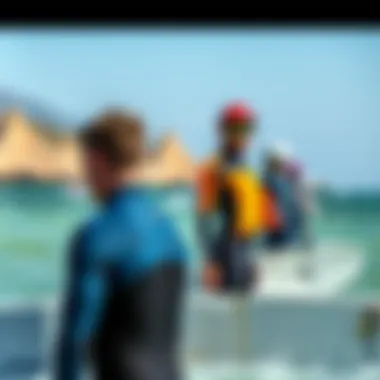
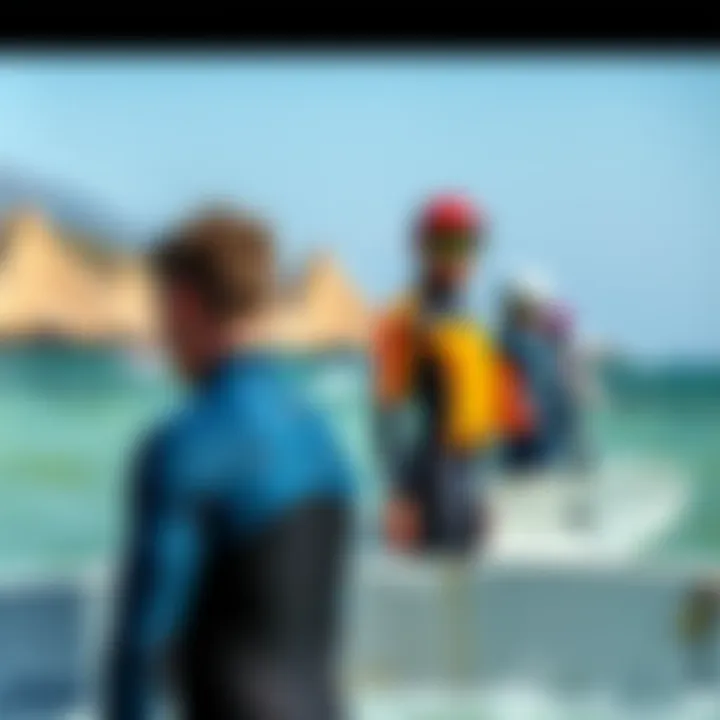
Next, let’s look at Duration of Exposure. How long you plan to be in the water plays an equally pivotal role in your wetsuit choice. If you're thinking about a quick jaunt, you might not need a suit as robust as someone who plans to be out all day. Generally, if you're going to be flowing with the winds for several hours, a thicker wetsuit provides the security against the chill.
The key characteristic to remember is that your body loses heat more rapidly in cold water. The longer you're submerged, the greater the risk of getting too cold.
- Advantages: A well-chosen wetsuit can prolong your time on the water without succumbing to cold.
- Disadvantages: Overestimating exposure time can lead to unnecessary discomfort. A lightweight wetsuit for a long session may leave you shivering.
Budget vs. Quality
Investment Value
Choosing between price and quality often feels like a balancing act for kiteboarders. The Investment Value of a wetsuit is all about considering it as a long-term investment rather than a one-time purchase. A high-quality wetsuit can last for several seasons if it's properly cared for, saving you money in the long run. This highlights the importance of considering both durability and function.
- Key characteristic: A well-made wetsuit often features superior stitching and material quality, providing a better functional lifespan.
- Advantages: Investing in quality means enhanced comfort, added warmth, and improved performance on the water.
- Disadvantages: However, premium options can dent your wallet initially, making budget-conscious buyers hesitant.
Price Ranges of Leading Brands
Finally, we touch upon the Price Ranges of Leading Brands. Every marketplace has its share of high, mid, and low-budget wetsuits. Understanding what you can expect from each price tier can further refine your choice. While some brands command a higher price due to their reputation and innovations, they often come with features that cater specifically to kiteboarders’ needs.
- Key characteristic: For instance, leading brands like O'Neill, Quiksilver, and Rip Curl offer models designed with kiteboarding in mind, featuring extra stretch and warmth.
- Advantages: High-quality suits with advanced designs typically cater to comfort and performance.
- Disadvantages: Conversely, there are many affordable options available, but they might not stand the test of time or provide the warmth needed for extended sessions.
Maintenance and Care
Maintaining and caring for your wetsuit is not just about keeping it clean; it’s about prolonging its lifespan and ensuring that it performs well when you're out on the water. Regular maintenance not only enhances the suit's durability but also plays a significant role in your comfort and safety during kiteboarding. Wetsuits, being specialized gear, come with specific requirements that don't always align with typical clothing care.
Cleaning Techniques
Proper Washing Methods
Cleaning your wetsuit is crucial to removing salt, sand, and other contaminants that can degrade the material over time. Using fresh water is the cornerstone of proper washing methods. Rinsing off your suit immediately after use helps prevent the build-up of grime that can cause odors and compromise the suit's integrity.
One effective approach is to use a wetsuit-specific cleaner, which is designed to break down any oils or residues without harming the neoprene. This specialized cleaner preserves the material and keeps it supple, extending its life significantly. Consider letting the suit soak in a diluted solution of this cleaner for around 15 to 30 minutes.
Remember, machine washing or drying can ruin the suit. The unique feature of washing by hand is the ability to control the gentleness of the process, an advantage when caring for sensitive materials like neoprene.
Drying Guidelines
How you dry your wetsuit is just as critical as how you wash it. The best way to dry a wetsuit is to hang it up using a wide hanger, which helps to avoid stretching. It’s important to avoid direct sunlight because UV rays can deteriorate the neoprene. Instead, opt for a shaded area, or a well-ventilated space, and give it time to dry naturally.
A unique guideline is to turn it inside out halfway through the drying process. This method ensures that both the internal and external surfaces dry properly. Rushing this drying phase—like tossing it in the dryer—can warp the material and ruin its fitting characteristics.
Storage Recommendations
Optimal Conditions for Longevity
Storing your wetsuit properly can make a world of difference in maintaining its utility and comfort. Ideally, you want to keep it in a cool, dark place, free from any sources of heat. This prevents the neoprene from breaking down or cracking. That means no cramped closets or hot attics.
By investing in a garment bag, you provide an extra layer of protection against dust and unwanted moisture. The unique feature of keeping it away from pressure points—like heavy items leaning on it—is essential. This can extend the life of the suit by keeping the seams intact and the material unstretched.
Avoiding Damage During Off-Season
When the kiteboarding season wraps up, most people shove their wetsuits in a corner and forget about them. This is a common mistake that can lead to long-term damage. To avoid this kind of wear and tear, it's best to clean and thoroughly dry your wetsuit before packing it away.
Consider rolling it rather than folding it, which helps prevent creases in critical areas. Furthermore, store it upright if possible, which can significantly reduce stress on the seams. By taking these precautions, you're ensuring your suit remains ready for action whenever the wind picks up again.
Proper maintenance is like insurance for your wetsuit. A little care goes a long way in keeping you warm and comfortable in those chilly waters.
By following these guidelines for washing, drying, and storing your wetsuit, you can help extend its life and efficiency. Not only will you enjoy better performance on the water, but you’ll also save money in the long run by avoiding frequent replacements. For more tips on wetsuit care, you can visit Wikipedia or join discussions on Reddit for real-world experiences from fellow kiteboarders.
End
In this engaging exploration of the warmest wetsuits, we have identified key components that kiteboarders must consider when selecting a wetsuit that enhances their performance while keeping them warm. The choice of wetsuit can significantly influence not just comfort but also safety during cold-water kiteboarding sessions. It's clear that with the right knowledge, kiteboarders can navigate through various options available to them and emerge wiser in their designs, materials, and fit.
Summary of Key Takeaways
To distill our discussion into manageable insights, here are the critical points to remember:
- Material Matters: The type of neoprene used directly affects warmth. High-quality, thicker neoprene provides better insulation.
- Design Elements: Features like seam construction, linings, and water resistance are essential for minimizing water circulation and maximizing warmth.
- Fit is Key: Proper fitting ensures that the wetsuit is snug enough to retain heat without compromising movement. Adjustments may be necessary for an ideal fit.
- Types of Wetsuits: Full wetsuits offer maximum coverage for colder conditions, while shorties may suffice in milder climates. Hybrid designs serve the best of both worlds.
- Maintenance for Longevity: Keeping the wetsuit clean and stored correctly extends its life, so develop a regular care routine.
Final Thoughts on Selecting Wetsuits for Kiteboarding
Kiteboarding should be an exhilarating experience, not a chilling one. Selecting the right wetsuit is about marrying personal comfort with functional warmth. With the myriad of wetsuit options and innovations available today, kiteboarders should feel empowered to make informed choices that best suit their activities in varying weather conditions. As you gear up and hit the waves, remember that the right wetsuit is just as crucial as your kite and board.
For further reading, you may explore more on this topic at Wikipedia or join kiteboarding discussions on Reddit.
Ultimately, investing in a high-quality wetsuit is an investment in your own comfort and safety while enjoying the thrills of kiteboarding in any climate.







